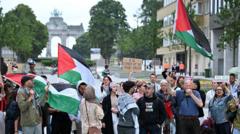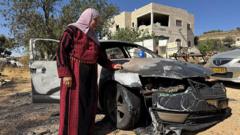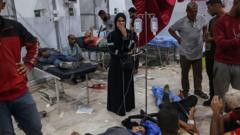Following the implementation of a US- and Israeli-supported aid distribution system in Gaza, reports of gunfire and chaos related to aid collection have become alarmingly frequent. Over 500 individuals have reportedly been killed while seeking humanitarian assistance, primarily attributed to Israeli fire, though the situation remains complex and confused.
Chaos and Gunfire: A Month of Aid Distribution in Gaza

Chaos and Gunfire: A Month of Aid Distribution in Gaza
A month after the introduction of a new aid system in Gaza, incidents of violence have surged, raising concerns over safety and humanitarian access.
A month into the controversial aid distribution system in Gaza, aimed at alleviating the humanitarian crisis, the reality has been marred by violence, panic, and a rising death toll. The initiative, backed by the United States and Israel, has seen a troubling uptick in gunfire incidents as people attempt to collect aid, with the Gaza health ministry reporting over 500 deaths and around 4,000 injuries in this period, largely attributed to Israeli forces.
BBC Verify's analysis of numerous videos reveals a stark picture of chaos, with sound recordings capturing gunfire in areas crowded with people seeking aid. While the Israeli Defense Forces (IDF) claim they fired "warning shots" at individuals deemed a threat, establishing who exactly is responsible for the fatalities has proven difficult, as many eyewitnesses point to Israeli fire.
The aid initiative, which began its operations on May 26 following a partial easing of an 11-week blockade imposed by Israel, has sparked significant international criticism. Humanitarian organizations, including the UN and the Red Cross, have condemned the military involvement in aid distribution, warning that the strategy militarizes humanitarian assistance and endangers civilians. They maintain that the existing distribution networks should not be bypassed, as the current arrangements compel aid seekers to navigate dangerous territories.
In the wake of the changes, the IDF has stated that they are attempting to better their operational responses to minimize frictions. They contend that Hamas actively disrupts aid distribution, further complicating the scenario. Guy Mencer, an Israeli government spokesperson, refuted the death toll figures attributed to the aid collection incidents.
An analysis of several incidents reveals extreme distress among the population: gunfire can be heard in videos documenting vast crowds scrambling for aid, while others showcase the immediate aftermath of shooting, with bodies being collected from the streets. Reports from aid workers highlight the increasing frequency of severe injuries, particularly gunshot wounds.
Additional incidents have emerged at non-GHF-associated aid distribution sites, where lethal drone strikes and artillery shots are alleged to have caused significant casualties. Despite claims of securing safe passages for aid seekers, confusion remains rampant, contributing to more deaths associated with gunfire.
While the GHF has announced the distribution of millions of meals to Gazans, voices from various humanitarian organizations emphasize the need for a thorough reevaluation of the approach, advocating for increased humanitarian assistance as the pathway to restore safety and order amidst an ongoing crisis.
The situation in Gaza demonstrates the challenge of conducting humanitarian aid operations in an active conflict zone, where every gathering of civilians is fraught with risk, raising serious concerns over potential violations of international law regarding civilian safety and access to humanitarian relief.





















